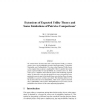Free Online Productivity Tools
i2Speak
i2Symbol
i2OCR
iTex2Img
iWeb2Print
iWeb2Shot
i2Type
iPdf2Split
iPdf2Merge
i2Bopomofo
i2Arabic
i2Style
i2Image
i2PDF
iLatex2Rtf
Sci2ools
ISIPTA
2003
IEEE
2003
IEEE
Extensions of Expected Utility Theory and Some Limitations of Pairwise Comparisons
We contrast three decision rules that extend Expected Utility to contexts where a convex set of probabilities is used to depict uncertainty: Γ-Maximin, Maximality, and E-admissibility. The rules extend Expected Utility theory as they require that an option is inadmissible if there is another that carries greater expected utility for each probability in a (closed) convex set. If the convex set is a singleton, then each rule agrees with maximizing expected utility. We show that, even when the option set is convex, this pairwise comparison between acts may fail to identify those acts which are Bayes for some probability in a convex set that is not closed. This limitation affects two of the decision rules but not E-admissibility, which is not a pairwise decision rule. E-admissibility can be used to distinguish between two convex sets of probabilities that intersect all the same supporting hyperplanes.
| Added | 04 Jul 2010 |
| Updated | 04 Jul 2010 |
| Type | Conference |
| Year | 2003 |
| Where | ISIPTA |
| Authors | Mark J. Schervish, Teddy Seidenfeld, Joseph B. Kadane, Isaac Levi |
Comments (0)

